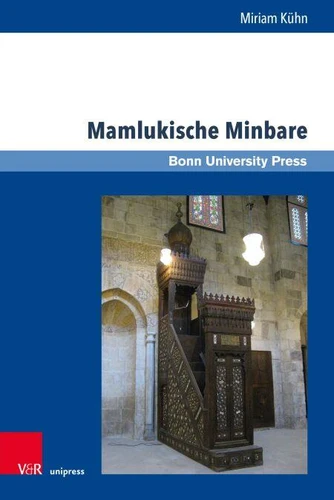Mamlukische Minbare. Islamische Predigtkanzeln in Ägypten, Syrien, Libanon, Israel und den Palästinensischen Autonomiegebieten zwischen 1250 und 1517
Par : ,Formats :
Disponible dans votre compte client Decitre ou Furet du Nord dès validation de votre commande. Le format PDF est :
- Compatible avec une lecture sur My Vivlio (smartphone, tablette, ordinateur)
- Compatible avec une lecture sur liseuses Vivlio
- Pour les liseuses autres que Vivlio, vous devez utiliser le logiciel Adobe Digital Edition. Non compatible avec la lecture sur les liseuses Kindle, Remarkable et Sony
 , qui est-ce ?
, qui est-ce ?Notre partenaire de plateforme de lecture numérique où vous retrouverez l'ensemble de vos ebooks gratuitement
Pour en savoir plus sur nos ebooks, consultez notre aide en ligne ici
- Nombre de pages728
- FormatPDF
- ISBN978-3-8470-0806-4
- EAN9783847008064
- Date de parution07/10/2019
- Protection num.pas de protection
- Taille50 Mo
- Infos supplémentairespdf
- ÉditeurV&R Unipress
Résumé
In diesem Band wird eine umfangreiche und beispiellose Erfassung, Dokumentation und Klassifikation erhaltener mamlukischer Minbare in Ägypten, Syrien, dem Libanon, Israel und den Palästinensischen Autonomiegebieten vorgelegt. Sie werden erstmals als gestiftete, geschaffene, genutzte und mit Bedeutung versehene Objekte der mamlukenzeitlichen Gesellschaft vorgestellt. Der gesellschaftliche Kontext der Stiftung der Minbare wird als eine der entscheidenden Ursachen für die Vielzahl erhaltener und unter mamlukischer Herrschaft entstandener Minbare herausgearbeitet.
Schließlich stellt Miriam Kühn die Nutzung dieses für die Freitagsmoschee bestimmenden Ausstattungsgegenstandes durch Hinzuziehung von mamlukischen Bild- und Schriftquellen sowie den Inschriften der Minbare dar. This publication is dedicated to the documentation and analysis of the structure and decoration, endowment and use of mamluk minbars. For the first time these objects are presented as endowed, created, used and meaningful objects of the society under Mamluk rule.
The work is based on a survey of preserved minbars in Egypt, Syria, Lebanon, Israel and the areas of Palestinian Authority control carried out between 2006 and 2013. The visual aspects of the minbars are described and classified. Furthermore their endowment is examined and emphasized as the main reason for the numerousness of minbars preserved from Mamluk rule. Finally, the use of minbars is explored by using Mamluk visual and written sources as well as their inscriptions.
Schließlich stellt Miriam Kühn die Nutzung dieses für die Freitagsmoschee bestimmenden Ausstattungsgegenstandes durch Hinzuziehung von mamlukischen Bild- und Schriftquellen sowie den Inschriften der Minbare dar. This publication is dedicated to the documentation and analysis of the structure and decoration, endowment and use of mamluk minbars. For the first time these objects are presented as endowed, created, used and meaningful objects of the society under Mamluk rule.
The work is based on a survey of preserved minbars in Egypt, Syria, Lebanon, Israel and the areas of Palestinian Authority control carried out between 2006 and 2013. The visual aspects of the minbars are described and classified. Furthermore their endowment is examined and emphasized as the main reason for the numerousness of minbars preserved from Mamluk rule. Finally, the use of minbars is explored by using Mamluk visual and written sources as well as their inscriptions.
In diesem Band wird eine umfangreiche und beispiellose Erfassung, Dokumentation und Klassifikation erhaltener mamlukischer Minbare in Ägypten, Syrien, dem Libanon, Israel und den Palästinensischen Autonomiegebieten vorgelegt. Sie werden erstmals als gestiftete, geschaffene, genutzte und mit Bedeutung versehene Objekte der mamlukenzeitlichen Gesellschaft vorgestellt. Der gesellschaftliche Kontext der Stiftung der Minbare wird als eine der entscheidenden Ursachen für die Vielzahl erhaltener und unter mamlukischer Herrschaft entstandener Minbare herausgearbeitet.
Schließlich stellt Miriam Kühn die Nutzung dieses für die Freitagsmoschee bestimmenden Ausstattungsgegenstandes durch Hinzuziehung von mamlukischen Bild- und Schriftquellen sowie den Inschriften der Minbare dar. This publication is dedicated to the documentation and analysis of the structure and decoration, endowment and use of mamluk minbars. For the first time these objects are presented as endowed, created, used and meaningful objects of the society under Mamluk rule.
The work is based on a survey of preserved minbars in Egypt, Syria, Lebanon, Israel and the areas of Palestinian Authority control carried out between 2006 and 2013. The visual aspects of the minbars are described and classified. Furthermore their endowment is examined and emphasized as the main reason for the numerousness of minbars preserved from Mamluk rule. Finally, the use of minbars is explored by using Mamluk visual and written sources as well as their inscriptions.
Schließlich stellt Miriam Kühn die Nutzung dieses für die Freitagsmoschee bestimmenden Ausstattungsgegenstandes durch Hinzuziehung von mamlukischen Bild- und Schriftquellen sowie den Inschriften der Minbare dar. This publication is dedicated to the documentation and analysis of the structure and decoration, endowment and use of mamluk minbars. For the first time these objects are presented as endowed, created, used and meaningful objects of the society under Mamluk rule.
The work is based on a survey of preserved minbars in Egypt, Syria, Lebanon, Israel and the areas of Palestinian Authority control carried out between 2006 and 2013. The visual aspects of the minbars are described and classified. Furthermore their endowment is examined and emphasized as the main reason for the numerousness of minbars preserved from Mamluk rule. Finally, the use of minbars is explored by using Mamluk visual and written sources as well as their inscriptions.



